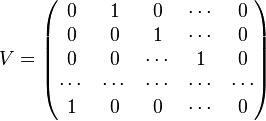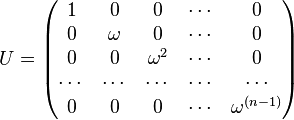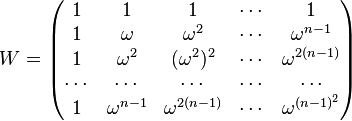Generalized Clifford algebra
In mathematics, a Generalized Clifford algebra (GCA) is an associative algebra that generalizes the Clifford algebra, and goes back to the work of Hermann Weyl,[1] who utilized and formalized these clock-and-shift operators introduced by J. J. Sylvester (1882),[2] and organized by Cartan (1898)[3] and Schwinger.[4]
Clock and shift matrices find routine applications in numerous areas of mathematical physics, providing the cornerstone of quantum mechanical dynamics in finite-dimensional vector spaces.[5][6][7] The concept of a spinor can further be linked to these algebras.[6]
The term Generalized Clifford Algebras can also refer to associative algebras that are constructed using forms of higher degree instead of quadratic forms.[8][9][10][11]
Definition and properties
Abstract definition
The n-dimensional generalized Clifford algebra is defined as an associative algebra over a field F, generated by[12]
and
∀ j,k,l,m = 1,...,n.
Moreover, in any irreducible matrix representation, relevant for physical applications, it is required that
∀ j,k = 1,...,n, and  gcd
gcd . The field F is usually taken to be the complex numbers C.
. The field F is usually taken to be the complex numbers C.
More specific definition
In the more common cases of GCA,[6] the n-dimensional generalized Clifford algebra of order p has the property ωkj = ω,  for all j,k, and
for all j,k, and  . It follows that
. It follows that
and
for all j,k,l = 1,...,n, and
is the pth root of 1.
There exist several definitions of a Generalized Clifford Algebra in the literature.[13]
- Clifford algebra
In the (orthogonal) Clifford algebra, the elements follow an anticommutation rule, with ω = −1, and p = 2.
Matrix representation
The Clock and Shift matrices can be represented[14] by n×n matrices in Schwinger's canonical notation as
 ,
,  ,
,  .
.
Notably, Vn = 1, VU = ωUV (the Weyl braiding relations), and W−1VW = U (the Discrete Fourier transform). With e1 = V , e2 = VU, and e3 = U, one has three basis elements which, together with ω, fulfil the above conditions of the Generalized Clifford Algebra (GCA).
These matrices, V and U, normally referred to as "shift and clock matrices", were introduced by J. J. Sylvester in the 1880s. (Note that the matrices V are cyclic permutation matrices that perform a circular shift; they are not to be confused with upper and lower shift matrices which have ones only either above or below the diagonal, respectively).
Specific examples
- Case n = p = 2.
In this case, we have ω = −1, and
 ,
,  ,
, 
thus
 ,
,  ,
,  ,
,
which constitute the Pauli matrices.
- Case n = p = 4,
In this case we have ω = i, and
 ,
,  ,
, 
and e1, e2, e3 may be determined accordingly.
See also
References
- ↑ Weyl, H., "Quantenmechanik und Gruppentheorie", Zeitschrift für Physik, 46 (1927) pp. 1–46, doi:10.1007/BF02055756. Weyl, H., The Theory of Groups and Quantum Mechanics (Dover, New York, 1931)
- ↑ Sylvester, J. J., (1882), Johns Hopkins University Circulars I: 241-242; ibid II (1883) 46; ibid III (1884) 7–9. Summarized in The Collected Mathematics Papers of James Joseph Sylvester (Cambridge University Press, 1909) v III . online and further.
- ↑ Cartan, E. (1898). "Les groupes bilinéaires et les systèmes de nombres complexes." Annales de la faculté des sciences de Toulouse 12.1 B65-B99. online
- ↑ Schwinger, J. (1960), "Unitary operator bases", Proc Natl Acad Sci U S A, April; 46(4): 570–579, PMCID: PMC222876; ibid, "Unitary transformations and the action principle", 46(6): 883–897, PMCID: PMC222951
- ↑ Santhanam, T. S.; Tekumalla, A. R. (1976). "Quantum mechanics in finite dimensions". Foundations of Physics 6 (5): 583. doi:10.1007/BF00715110.
- ↑ 6.0 6.1 6.2 See for example: A. Granik, M. Ross: On a new basis for a Generalized Clifford Algebra and its application to quantum mechanics, in: Rafal Ablamowicz, Joseph Parra, Pertti Lounesto (eds.): Clifford Algebras with Numeric and Symbolic Computation Applications, Birkhäuser, 1996, ISBN 0-8176-3907-1, p. 101–110
- ↑ A. K. Kwaśniewski: On Generalized Clifford Algebra C4(n) and GLq(2;C) quantum group
- ↑ Tesser, Steven Barry (2011). "Generalized Clifford algebras and their representations". In Micali, A.; Boudet, R.; Helmstetter, J. Clifford algebras and their applications in mathematical physics. Dordrecht: Springer. pp. 133–141. ISBN 978-90-481-4130-2.
- ↑ Childs, Lindsay N. (30 May 2007). "Linearizing of n-ic forms and generalized Clifford algebras". Linear and Multilinear Algebra 5 (4): 267–278. doi:10.1080/03081087808817206.
- ↑ Pappacena, Christopher J. (July 2000). "Matrix pencils and a generalized Clifford algebra". Linear Algebra and its Applications 313 (1-3): 1–20. doi:10.1016/S0024-3795(00)00025-2.
- ↑ Chapman, Adam; Kuo, Jung-Miao (April 2015). "On the generalized Clifford algebra of a monic polynomial". Linear Algebra and its Applications 471: 184–202. doi:10.1016/j.laa.2014.12.030.
- ↑ For a serviceable review, see Vourdas A. (2004), "Quantum systems with finite Hilbert space", Rep. Prog. Phys. 67 267. doi: 10.1088/0034-4885/67/3/R03.
- ↑ See for example the review provided in: Tara L. Smith: Decomposition of Generalized Clifford Algebras
- ↑ Alladi Ramakrishnan: Generalized Clifford Algebra and its applications – A new approach to internal quantum numbers, Proceedings of the Conference on Clifford algebra, its Generalization and Applications, January 30 – February 1, 1971, Matscience, Madras 20, pp. 87–96
Further reading
- R. Jagannathan, On generalized Clifford algebras and their physical applications
- K. Morinaga, T. Nono (1952): On the linearization of a form of higher degree and its representation, J. Sci. Hiroshima Univ. Ser. A, 16, pp. 13–41
- O. Morris (1967): On a Generalized Clifford Algebra, Quart. J. Math (Oxford), 18, pp. 7–12
- O. Morris (1968): On a Generalized Clifford Algebra II, Quart. J. Math (Oxford), 19, pp. 289–299








